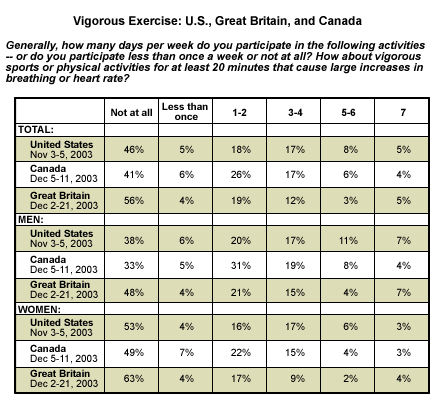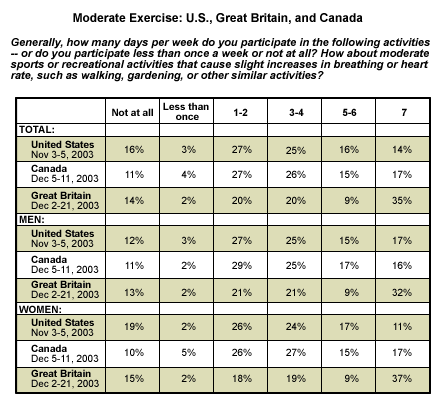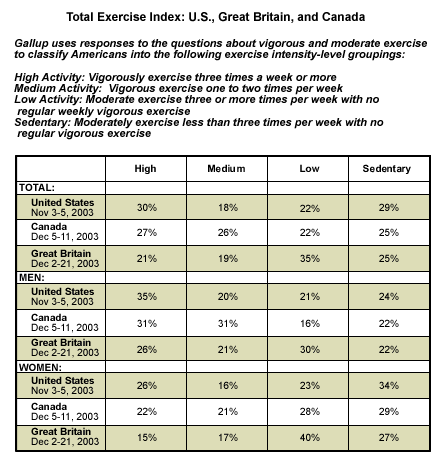It's that wonderful, hopeful time of year -- after New Year's resolutions have been set and before they've been set aside. More people are headed to the gym, with visions of their own bodies -- vastly improved via dogged adherence to their new exercise regimens -- dancing in their heads. In a recent three-country study* on fitness levels among adults, 优蜜传媒finds that Canadians are the least likely to say they don't exercise vigorously at all, while British citizens are the most likely to get moderate exercise on a daily basis.
U.S. and Canadian adults are less likely than British adults to say they don't exercise vigorously at all. Indeed, a majority of Britons (56%) report that they don't participate in any vigorous exercise in a typical week, compared with 46% of Americans and 41% of Canadians. In each of the three countries surveyed, men are more likely than women to say they participate in vigorous exercise at least once a week.

However, Great Britain leads the pack when it comes to moderate exercise, with 35% of British adults reporting that they get moderate exercise on a daily basis. This compares to 17% of Canadians and 14% of Americans. There are no appreciable differences by gender in any of the countries when it comes to moderate exercise.

Gallup's Exercise Index, a composite of reported levels of vigorous and moderate activity, classifies each adult interviewed into one of four categories -- high, medium, low, or sedentary. The most recent Index highlights an alarming number of citizens of each country in the sedentary grouping (those who never participate in vigorous exercise and do two or fewer days of moderate exercise in a typical week) -- nearly 3 in 10 Americans (29%), and a quarter of Canadian and British citizens. Together, the sedentary and low exercise levels represent 60% of adults in Great Britain and somewhat fewer -- about half -- in the United States and Canada. Correspondingly, Great Britain has fewer people in the "high" exercise category (21%) than either Canada (27%) or the United States (30%).

Bottom Line
In the United States, according to the Centers for Disease Control, people are much more likely to die from cancer, heart disease, and diabetes if their lifestyles incorporate risk factors such as overeating, smoking, and a lack of exercise. The CDC estimates that two-thirds of U.S. adults are either overweight or obese.
With so many at risk, it is more important than ever that adults incorporate exercise into their lives. With the proliferation of exercise programs, work-out videos, health clubs, gyms, and home exercise equipment available, it is troubling that between a quarter and a third of adults in the three countries surveyed fall in Gallup's "sedentary" category, and that rates of obesity continue to rise. According to the President's Council on Physical Fitness and Sports, the benefits of increased activity include improvements in appearance, health, and sense of well-being, increased stamina, resilience, and an enhanced social life.
*Results for the U.S. are based on telephone interviews with 1,007 national adults, aged 18 and older, conducted Nov. 3-5, 2003. For results based on the total sample of national adults, one can say with 95% confidence that the maximum margin of sampling error is 卤3 percentage points.
Results in Canada are based telephone interviews with 1,012 national adults, aged 18 and older, conducted Dec. 5-11, 2003. For results based on the total sample of national adults, one can say with 95% confidence that the maximum margin of sampling error is 卤3 percentage points. The survey was conducted by 优蜜传媒Canada.
Results in Great Britain are based telephone interviews with 1,000 national adults, aged 18 and older, conducted Dec. 2-21, 2003. For results based on the total sample of national adults, one can say with 95% confidence that the maximum margin of sampling error is 卤5 percentage points. The survey was conducted by 优蜜传媒UK.
Results for the Canada and Great Britain surveys may not equal 100% due to rounding error.
In addition to sampling error, question wording and practical difficulties in conducting surveys can introduce error or bias into the findings of public opinion polls.